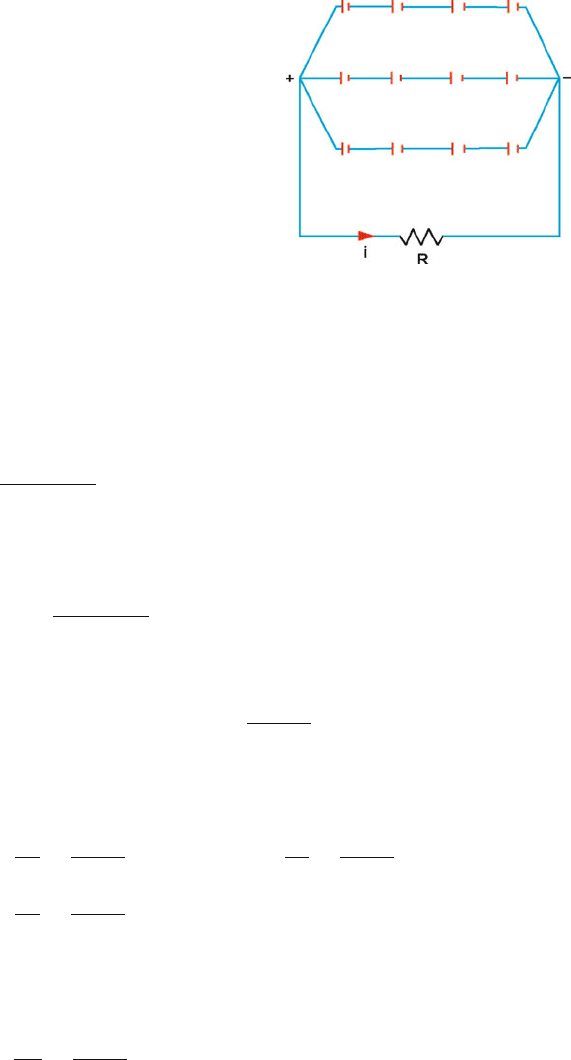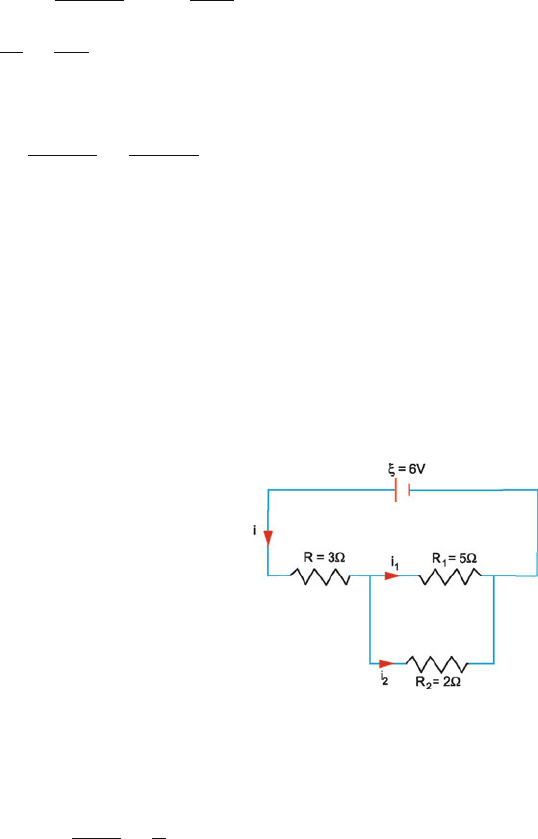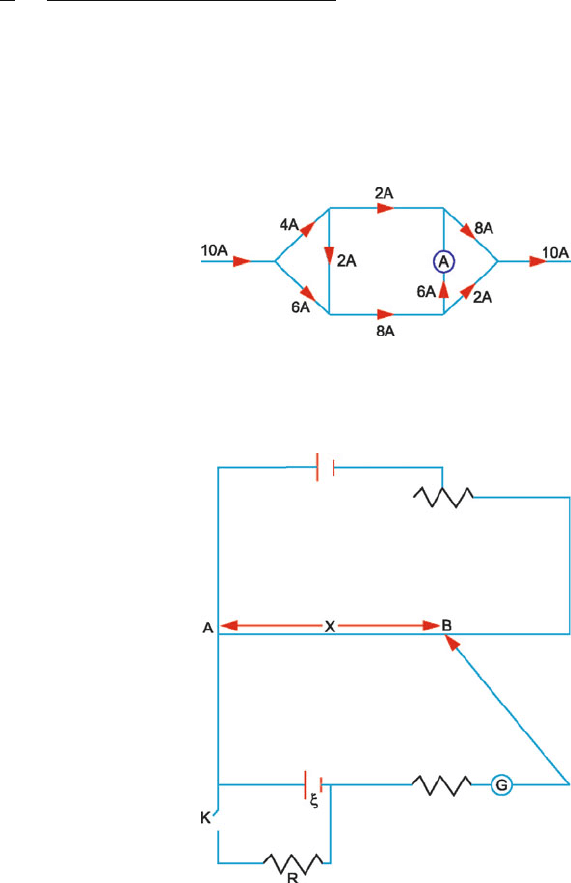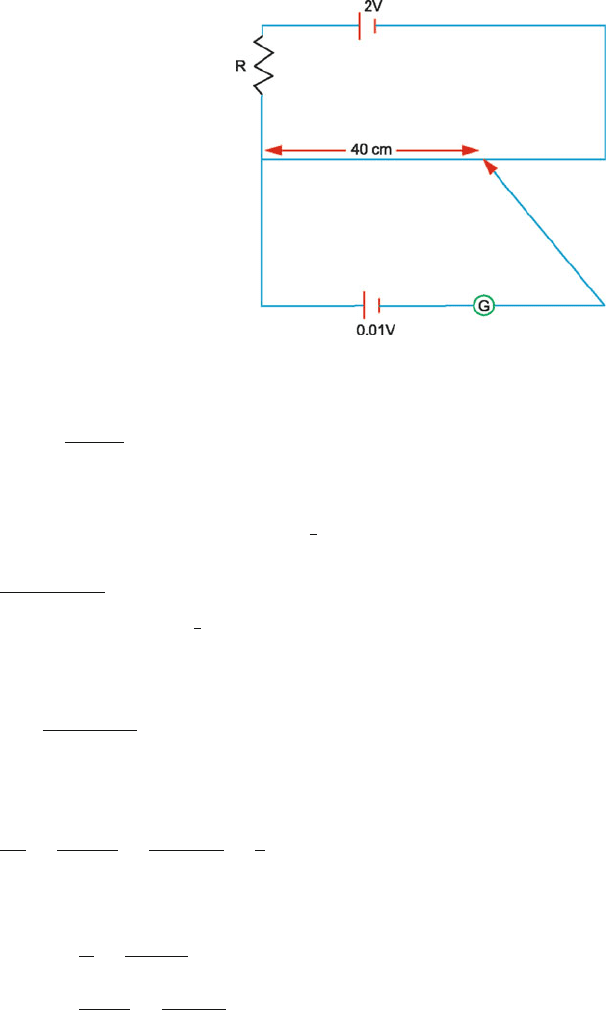Kamal A.A. 1000 Solved Problems in Classical Physics: An Exercise Book
Подождите немного. Документ загружается.


560 12 Electric Circuits
12.20 H = P
1
t
1
=
V
2
R
1
t
1
where H is joule heat and t is time
∴ t
1
=
H
V
2
R
1
(coil 1)
t
2
=
H
V
2
R
2
(coil 2)
(a) t =
H
V
2
R =
H
V
2
(R
1
+ R
2
) = t
1
+ t
2
(coils in series)
(b)
1
t
1
=
V
2
HR
1
(coil 1)
1
t
2
=
V
2
HR
2
(coil 2)
∴
1
t
1
+
1
t
2
=
V
2
H
1
R
1
+
1
R
2
=
V
2
HR
=
1
t
or t =
t
1
t
2
t
1
+ t
2
(coils in parallel)
12.21
(a) i =
ξ
R
1
+ R
2
+r
=
24
4 + 6 + 2
= 2A
P
1
= i
2
R
1
= 2
2
× 4 = 16 W
P
2
= i
2
R
2
= 2
2
× 6 = 24 W
(b) Effective resistance of R
1
and R
2
in parallel is
R =
R
1
R
2
R
1
+ R
2
=
4 × 6
4 + 6
= 2.4
i =
ξ
R +r
=
24
2.4 + 2
= 5.45 A
i
1
=
iR
2
R
1
+ R
2
=
5.45 × 6
4 + 6
= 3.27 A
i
2
=
iR
1
R
1
+ R
2
=
5.45 × 4
4 + 6
= 2.18 A
P
1
= i
2
1
R
1
= (3.27)
2
× 4 = 42.8W
P
2
= i
2
2
R
2
= (2.18)
2
× 6 = 28.5W

12.3 Solutions 561
12.22 Total resistance of the cable
R = 0.7 × 30 = 21
Voltage V = 100 kV = 10
5
V
Power P = 10
4
kW = 10
7
W
Current I =
P
V
=
10
7
10
5
= 100 A
Power dissipated = i
2
R = (100)
2
× 21 = 2.1 × 10
5
W
Fractional power loss =
2.1 × 10
5
10
7
= 0.021 or 2.1%
12.23 Let each of the three resistances be r. In the series arrangement the effective
resistance, R
1
= 3r:
P
1
=
ξ
2
R
1
=
ξ
2
3r
= 10
∴
ξ
2
r
= 30 (1)
In the parallel arrangement the effective resistance R
2
= r/3:
P
2
=
ξ
2
R
2
=
3ξ
2
r
= 3 ×30 = 90 W
wherewehaveused(1).
12.24 If the heater resistance is R
0
,
R
0
=
V
2
P
=
(100)
2
1000
= 10
The combined resistance of R
0
and R in parallel is
10R
R + 10
.Asthisisin
series with 10 , the effective resistance of the circuit
R
e
= 10 +
10R
R + 10
=
20R + 100
R + 10
If P
is the power of the heater
R
e
=
20R + 100
R + 10
=
V
2
P
=
(100)
2
62.5
Solving for R, we find R = 5 .

562 12 Electric Circuits
12.3.2 Cells
12.25 Let n cells of emf ξ and internal resistance r be wrongly connected. The
effective emf of the battery is (12–2n) ξ. When the two cells and the battery
aid each other, the net emf is (12−2n)ξ +2ξ or (14−2n)ξ. The total internal
resistance is 14r. By problem, when the two cells and battery aid each other
(14 − 2n)ξ = 3 ×14r (1)
and when the two cells and battery oppose each other, the net emf is
(12−2n)ξ − 2ξ or (10−2n)ξ, the total internal resistance being 14r.By
problem
(10 − 2n)ξ = 2 ×14r (2)
Dividing (1) by (2)
14 − 2n
10 − 2n
=
3
2
whence n = 1.
12.26 The total number of cells is N = m × n. The emf for each row of cells
will be nξ and the combined internal resistance nr (Fig. 12.39). The effective
emf for m rows would again be nξ, but because the rows are in parallel, the
effective internal resistance would become nr /m. The total resistance then
becomes R + nr/m. The current through R will be
i =
nξ
R +
nr
m
=
mnr
Rm + nr
=
Nr
Rm + nr
(1)
Writing m = N/n in (1) and holding N as constant, maximum current i is
found by setting
∂i
∂n
= 0. This gives
n
2
=
RN
r
=
Rmn
r
or R =
nr
m
But the right-hand side is equal to the total internal resistance of the cells.
Thus the current is maximum when the cells are arranged such that their
total internal resistance is equal to the external resistance. In particular, for a
single cell, m = n = 1, and the condition for maximum current is R = r,a
result which is identical with that of prob. (12.19).

12.3 Solutions 563
Fig. 12.39
12.27 Let ξ be the emf of each cell, i the current flowing in the circuit, r
1
and r
2
be the internal resistance of the first and the second cells, respectively. The
potential drop across the first cell will be
V
1
= ξ −ir
1
= 0 (by problem) (1)
i =
2ξ
r
1
+r
2
+ R
(2)
Combining (1) and (2)
ξ = ir
1
=
2ξr
1
r
1
+r
2
+ R
∴ R = r
1
−r
2
12.28 Total power P = P
1
+ P
2
+ P
3
=
10
3
Wh
2h
= 500 W
P
1
: P
2
: P
3
= 5 : 3 : 2
∴ P
1
= 250 W, P
2
= 150 W, P
3
= 100 W
R
1
=
V
2
P
1
=
(200)
2
250
= 160 , R
2
=
V
2
P
2
=
(200)
2
150
= 267 ,
R
3
=
V
2
P
3
=
(200)
2
100
= 400
In series total resistance R
= R
1
+ R
2
+ R
3
= 160 +267 + 400 = 827 .
Required power for the series arrangement
P
=
V
2
R
=
(248)
2
827
= 74.4W

564 12 Electric Circuits
12.29 The current flows from positive to negative terminal inside the battery. The
potential difference between the two terminals of the battery would be
V = ξ +ir = 2 +5 × 0.1 = 2.5V
12.30
(a) The effective resistance in the circuit (Fig. 12.40) from 3 in series with
5 and 2 in parallel
R
0
= R +
R
1
R
2
R
1
+ R
2
= 3 +
2 × 5
2 + 5
= 4.43
i =
ξ
R
0
=
6
4.43
= 1.35 A
(b) i
1
=
iR
2
R
1
+ R
2
=
1.35 × 2
5 + 2
= 0.386
P
1
= i
1
2
R
1
= (0.386)
2
× 5 = 0.74 W
i
2
= i −i
1
= 1.35 −0.386 = 0.964 A
P
2
= i
2
2
R
2
= (0.964)
2
× 2 = 1.86 W
P = i
2
R = (1.35)
2
× 3 = 5.47 W
(c) Total power dissipated by the resistances
= P
1
+ P
2
+ P = 0.74 + 1.86 +5.47 = 8.07 W 8.1W
Power supplied by the battery = ξi = 6 × 1.35 = 8.1W
Fig. 12.40
12.3.3 Instruments
12.31 P.D across AB is
ξ R
R +r
=
l
l
0
ξ
0

12.3 Solutions 565
ξ × 20
20 +r
=
150
l
0
ξ
0
ξ × 10
10 +r
=
120
l
0
ξ
0
Dividing the last two equations
2 (10 + r)
20 +r
=
5
4
whence r = 6.67 .
12.32 For the section ABC
i =
ξ
1
R +r
=
2.2
1 + 0.1
= 2A
In the s ection BCD also i = 2A.
The resistance of 26 cm wire =
26
50
× 1 = 0.52 .
Neglecting the internal resistance of the second cell
ξ
2
= 2 ×0.52 = 1.04 V
as no current flows through the galvanometer
12.33
(a) V
AB
= V
AD
; V
BC
= V
DC
∴ i
1
P = i
2
R (1)
i
1
Q = i
2
S (2)
Dividing (1) by (2)
P
Q
=
R
S
(3)
(b) Assume that a non-zero current flows through the galvanometer of resis-
tance G. Applying the junction theorem at A
i = i
1
+i
2
(4)
Applying the loop theorem to the loop ABDA and noting that there is no
emf in this loop
i
g
G +i
1
P − i
2
R = 0(5)

566 12 Electric Circuits
Applying the loop theorem to the loop BCDB, which also does not have
an emf
(i
1
−i
g
)Q −i
g
G −(i
2
−i
g
)s = 0(6)
Combining (4), (5) and (6)
i
g
i
=
QR − PS
G(Q + S) + (P + R)(G + Q + S)
Note that i
g
= 0ifQR − PS = 0, which is identical with the condi-
tion (3).
12.34 Apply the junction theorem to obtain currents in various branches as indi-
cated in Fig. 12.41. Current flowing through the ammeter is 6 A.
Fig. 12.41
12.35 Let the internal resistance of each battery be r, galvanometer resistance G
and the external resistance R. Then in the series arrangement, total resistance
in the circuit (Fig. 12.42)
Fig. 12.42

12.3 Solutions 567
(12.17)
R
eff
= G + R + 2r
Effective emf, ξ
eff
= 2 ×1.5 = 3V
ξ
eff
= i(G + R + 2r)
∴ 3 = 1 × (G + R + 2r) (1)
In the parallel arrangement, ξ
eff
= 1.5 V and the combined internal resis-
tance is
r ×r
r +r
= 0.5 r.
Total resistance in the circuit
R
eff
= G + R + 0.5r
1.5 = 0.6 × (G + R + 0.5r)
or 2.5 = G + R + 0.5r (2)
Subtracting (2) from (1), r = 0.333 .
12.36 When the key is closed P.D across R is
V = iR
and the emf of the cell is
ξ = i(R +r)
where r is the internal resistance of the cell.
ξ
V
=
R +r
R
= 1 +
r
R
When the key is open, let the balancing length be X
1
cm from the end A
against the emf ξ. When the key is closed, let the balancing length be X
2
against the P.D. of V volts:
ξ
V
=
X
1
X
2
= 1 +
r
R
52
40
= 1 +
r
5
∴ r = 1.5 .
12.37 Resistance (Fig. 12.43) of 40 cm of potentiometer wire =
40
100
× 10 = 4
P.D. across 40 cm wire due to 2 V cell is V =
2 × 4
10 + R
=
8
10 + R

568 12 Electric Circuits
Fig. 12.43
This is balanced by 0.01 V due to the s econd cell:
∴
8
10 + R
= 0.01
∴ R = 790
12.38 Resistance across ac (Fig. 12.20)is
1
4
× 12, 000 = 3000 . The com-
bined resistance of voltmeter (6000 ) in parallel with 3000 resistance is
6000 × 3000
6000 + 3000
= 2000 .
Resistance across bc is
3
4
× 12, 000 = 9000 . Effective resistance of the
circuit = 9000 + 2000 = 11, 000 .
P.D. across ac is
V =
220 × 2000
11, 000
= 40 V
Thus the voltmeter reads 40 V.
12.39
R
3.5
=
l
100 −l
=
30
100 − 30
=
3
7
∴ R = 1.5
12.40
(a)
N =
i
i
1
=
100 mA
1mA
= 100
S =
G
N − 1
=
80
100 − 1
= 0.808
A shunt of 0.808 should be provided for the moving coil meter.

12.3 Solutions 569
(b) Initially V = iG = 1 ×10
−3
× 80 = 0.08 V
N =
80
0.08
= 1000
R = (N − 1)G = (1000 − 1) × 80 = 79, 920
A resistance of 79,920 must be connected in series with the moving
coil galvanometer to give the required full scale deflection.
12.41
ξ = i(R +r) (by Ohm’s law)
9 = i(120 + 15)
∴ i =
1
15
A
The voltmeter would read
V = ξ −ir = 9 −
1
15
× 15 = 8V
12.42
S =
G
N − 1
i
1
i
=
1
N
=
1
100
or N = 100
∴ G = (N − 1)S = (100 − 1) ×1 = 99
12.3.4 Kirchhoff’s Laws
12.43 By the junction theorem
i = i
1
+i
2
(1)
Applying the loop theorem to the loop BE
1
AE
2
B, traversing clockwise
ξ
2
−i
2
r
2
− ξ
1
+i
1
r
1
= 0
∴ 2i
2
−i
1
= 20 −10 = 10 (2)
Applying the loop theorem to the loop BE
1
ARB
ξ
1
= i
1
r
1
+iR
